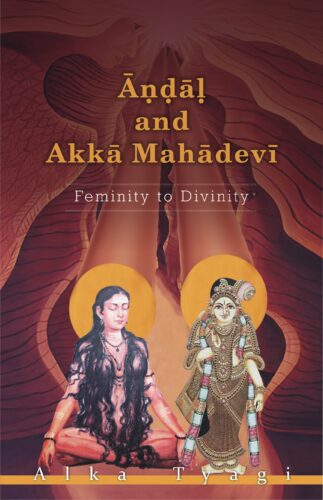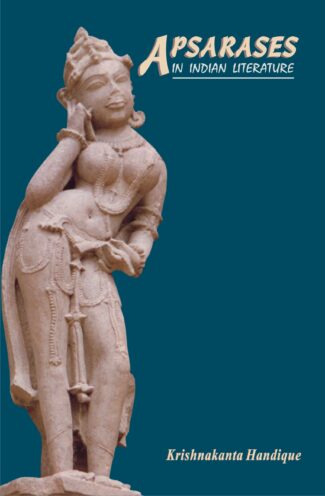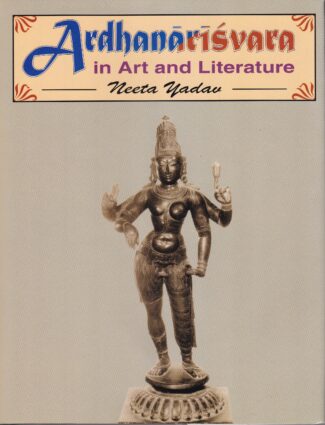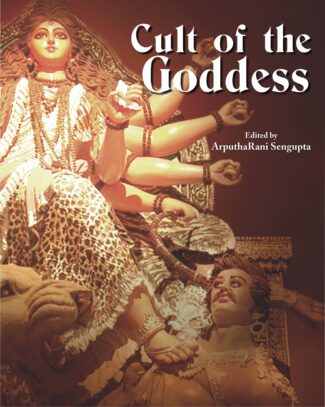Showing 1–10 of 51 results

This book helps one understand bhakti in its historical, philosophical and social persepectives.Two medieval women, Andal, from Tamil Srivaisnavite tradition, and Akka Mahadevi, from Virasaivite tradition, with their poetic renderings and life, are in focus. It also helps to extricate bhakti experience from its mystical aura and make it more accessible to our perceptive faculties.
Bhakti poetry is an amazing amalgamation of art, music, literature, philosophy, politics, soteriology and mysticism. Andal and Akka Mahadevi: Feminity to Divinity reflects this amalgamation in letter and spirit. Two medieval women, Andal, a ninth-century Alvar saint-poetess from Tamil Srivaisnavite tradition, and Akka Mahadevi, a twelfth-century Kannada saint-poetess from Virasaivite tradition, with their poetic renderings and life, got elevated to a stature beyond that of saints.
This book deals with three major aspects. One, understanding of bhakti in its historical, philosophical and social perspectives. It thus delves on the idea and phenomenon of bhakti, the ancient religions and the evolution of bhakti tradition in south India. Two, it portrays the life of poet-saints Andal and Akka Mahadevi and their chosen path of bhakti. Their poetic renderings Tiruppavai and Nachiar Tirumoli of Andal, and vacanas of Akka Mahadevi
have found merit in rituals, theatre, cinema, dance, painting and other arts. The textual analysis of their poetry is done from religious, literary and socio-political angles. Three, it reflects on how the works of these saints have percolated down to the living patterns in modern India; rather it is a dedication to the living traditions in bhakti.
This volume also helps to extricate bhakti experience from its mystical aura and make it more accessible to our perceptive faculties. Thus it enthuses the spirit of anyone, be an artist, a poet, a philosopher, or a scholar.

Indian literature abounds in a variety of myths and legends narrating allegorical/historical stories with moral teachings where celestial or semi-celestial beings, in particular the apsarases, occupy an important place. The work examines the origin and development of the institution of apsarases and their characteristics as described in the vast corpus of Vedic, Epic-Puranic and classical works, with a thorough study of the depiction of the legend of the Urvasi and Pururavas.
Indian literature abounds in a variety of myths and legends narrating allegorical/historical stories with moral teachings where celestial or semi-celestial beings, in particular the apsarases, occupy an important place. Of such legends, a few have become much popular and they reappear in the course of the history of literature at various stages. One such legend is that of Urvashi and Pururavas which is one of the most ancient legends of India, owing its origin to the Rigveda. This scholarly work, based on extensive original sources primary, comprising ancient Sanskrit texts, commentaries and glosses and modern literary pieces, kavyas and plays, as well as critical writings on these original works, studies the origin and development of the institution of apsarases and their characteristics as described in the vast corpus of Vedic, Epic-Puranic and classical works. In this context, it undertakes an interesting survey of the concept of nymphs (apsarases) in Indo-European, especially Greek mythology. Dr. Handique then thoroughly examines the depiction of the legend of Urvashi and Pururavas a favourite theme that has been immortalised in literary masterpieces in Indian literature as a whole: from the ancient Vedas and Puranas, the Harivamsha and Vikramorvashiyam to modern works like Urvashi Janani and Abhishapta Urvashi and stray poetic pieces. Presenting a new angle to the study, the book attempts to explore aspects of an age old tradition that bears close affinity with the institution of the apsarases in terms of mode of living worship and ideals like system of the devadasis. The book will prove invaluable to scholars of Indian mythology, culture and literature as well as interest general readers of ancient India’s legends and tales.

The scholarly work throws light on the artistic, aesthetic, literary and philosophical aspects of the Ardhanarisvara form of Siva. Providing a conceptual and historical background of the doctrines relating to Siva and Sakti worship it involves an iconographical study of the Ardhanarisvara image.
The scholarly work throws light on the artistic, aesthetic, literary and philosophical aspects of the Ardhanarishvara form of Shiva the form which is a divine expression of the amalgamation of the male and the female and is said to contain the whole world in it. Providing a conceptual and historical back-ground of the doctrines relating to Shiva and Shakti worship it involves an iconographical study of the Ardhanarishvara image, with the focus on its dress, ornaments, coiffure, posture and other features. With many visuals of the Ardhanarishvara images even the unpublished ones, it describes the images found in different parts of India and discusses the emergence of the deity relying on literary sources and theories. Explaining how the idea and actual representation of the unity of Shiva and Shakti came to acquire supreme importance with the growth of sects each worshipping the deity in its own form, Dr. Yadav points out that the Ardhanarishvara aspect is basically the output of the Tantra philosophy. Providing maps and line-drawings and a list of the places that have yielded Ardhanarishvara images, she makes an interesting and indepth analysis, based on extensive field-work, to come up with some brilliant and new explanations of the meaning and implications of the Ardhanarishvara.

This book delves into the contribution of feminist thinkers to examine their transformation of the activity of philosophy itself in the course of its contact with the feminine. Feminist philosophy brings about a greater awareness of philosophy’s relation to history, culture and other disciplines. There exists a struggle between femininity and feminism in the philosophical corpus of feminist thinkers with reference to the concept of care.
This book engages with the contribution of feminist thinkers to examine their transformation of the activity of philosophy itself in the course of its contact with the feminine. It also portrays how the feminist philosophy brings about a greater awareness of philosophy’s relation to history, culture and other disciplines. The author vividly puts into limelight the struggle between femininity and feminism in the philosophical corpus of feminist thinkers with reference to the concept of care. She takes pioneering feminism during the colonial period as its starting point and moves to its second wave during the post-colonial period to examine the trajectory of the concept of care.
Women do not form a homogeneous category. Therefore, this volume explores the extent to which Ramabai, Wollstonecraft, Okin, Gilligan and de Beauvoir can dialogue with the contemporary women. The relationship between these thinkers and their arguments is conceptually connected. The book addresses a few questions such as what is femininity, can one define feminine at all, how does a feminist feminine differ from a patriarchal feminine, can male philosophical frameworks be employed in feminist directions, among others.
The book also investigates the shifts from the colonial to post-colonial periods in the feminist approaches to care. It examines the possibility of integrating feminine care with the political concepts of justice and autonomy. An added task of intervening in the conceptual categories of Western feminism in an attempt to blur the strict binary between the Indian and Western traditions, is also explored.

This book drives one to the commendable social dignity that women adored during the Vedic period. The values of women were considered holy and pure. Literatures from Vedic period to the British rule glorify women and treat them with high esteem. Brahmavadini Gaargi, Durgavati of Gondavana, Rani Lakshmibai and Ahlyabhai, the towering personalities India, serve as the role model for Indian women and those who are engaged in women studies.
Respecting of women was prevalent in Indian culture ever since the Vedic period. The life values of women were considered holy and pure in those times. In the literature pertaining to Ramayana, Mahabharata, Upanishads, Buddhist, Middle Age and the British times, the highly respectable status of women is clearly shown. How differently were the women viewed at various times in different eras? Which were the women who made a special place for themselves in the different fields of life? In this context we remember Brahmavadini Gargi, Rajmahishi Durgavati of Gondvana, Queen Ahilyabai, Rani Lakshmibai of Jhansi, and some other women for their special contribution in maintaining the high status of women in Indian society.
Portraying the position of women in the ancient period and comparing them to the present times when life is full of struggles, this book becomes a valuable tool for the scholars engaged in women studies and also for the people specializing in Indian traditional culture besides the general readers.

This book provides an unparalleled insight in exploring the Great Goddess as she lived and still lives in the psyche of India and in the Greater India, over a period of five millennia. It traces the origin and trajectory of the evolution of the divine feminine force in the visual discourse. This multilayered goddess cult finds its expression in great achievements in art and culture in manifold forms and roles.
This volume is comprised of forty-one well researched and illustrated papers on Cult of the Goddess. It tries to trace the origin and trajectory of the divine feminine force in art and culture for over a period of five millennia, which is a great achievement in itself. While exploring the living tradition of the Great Goddess, the book offers unique insight to the psyche of India and the Greater India.
In the multifaceted goddess cult, the goddess takes diverse forms in her role as a destroyer of demonic forces and a donor of boons to her devotees. The goddess is also the divine consort, creator of the universe, source of progeny, prosperity and immortality. In her numerous roles the goddess maintains the equilibrium and sanctity of the universe. In mythology, the Mother Goddess is worshipped as the earth, fish, snake, tree or the forest.
The book delves deep into the imagination and religious lives of the people to understand the meaning of rituals, philosophy and metaphysics. The enduring appeal of the goddess in folk traditions and in classic literary sources is discussed from various points of view. The span and the depth of research encompassing the goddess include the shifting changes in the present era and finds her manifestations in Bonabibi, Kadamkottu Makkam and Manushi Swaccha Narayani, in addition to the well-known concept of Parashakti, Lakshmi, Sarasvati, Durga, Mahishasuramardini, Prajnaparamita, Hathor, Isis and Mother Mary.
This richly illustrated volume on Cult of the Goddess is a rare and priceless collection for art historians, researchers, students, and others interested in art, culture and religion.
Deviant Sex and Buddhism discusses deviant sexual practices recorded in Pali Sutta and Vinaya texts categorizing into normal, pathological and sociological. In Buddhist spirituality and philosophy, like in other religions, sex within the institution of marriage is admissible, while all other forms of sexual practices are immoral and denounced. A sexual act violating the norms of chastity and celibacy within the Buddhist community comes to be identified as a deviant sexual act.
At the backdrop this positioning, this volume engages one in a deep study of what were sensuality and sexuality in early Buddhism, Buddhist attitude to human body, and the definition of celibacy, chastity and normal deviant sexual behaviour along with the nuances of the other two forms of deviant sexual behaviour, i.e. pathological and sociological. Going by the Buddhist philosophy, any deviant sexual behaviour is connected with the issue of human suffering. Twofold sexual conformity – complete sexual abstinence and sex only with one’s own spouse – is emphasized while decrying all non-conforming sexual practices and deciding on a range for sexual acts including homosexual relationship.
This scholarly work should invigorate the interests of many researchers and academicians to take up further studies and researches on the topic, which has not yet been exposed to the literary world at length.

This work focuses on the various facets of queer activism, using different art forms like cinema, photography and literature to lay bare the queer and spatial politics of contemporary India. The key issues that have been explored through this book are necropolitics, issues surrounding sex-reassignment surgery (SRS), trans-feminism, trans-misogyny, translation of the queer geographies including deathscapes, AIDs citizenship and queer flânerie.
Representation of non-normative sexualities is still a tantalizing dream in India, even within the oblique and supposedly more liberal platforms like art and literature. Catering to this need, this study focuses on the exploration of the deviant sexualities in cinema, photography and literature, specially in the Indian context. Unfortunately, even within the queer artistic explorations, hijras have not been much represented and therefore the first part of the book aims to excavate the multiplicity of the transgender lives by analysing various art forms, having transgender cinema and hijra photographic series as the major thrust areas. These tales of plain subjugation hide convoluted issues like necropolitics, overlap among sports, gender identity and nationalism, crazy-queen syndrome, pansexuality, transfeminism and transmisogyny.
The second part of this book deals with the contemporary gay and lesbian literature and how a specific kind of spatial appropriation is visible there. Through these artistic works, there is an attempt to excavate the specific Indian queer spatial experiences which are quite different from the visibility-centric coming out narratives of the West. As opposed to perceiving invisibility only as a monolithic technique of erasure, these works demonstrate that secrecy and camouflage are also strategies to combat the insidious effects of homophobia. And since Indian spatial configuration produces many homosocial spaces, the unique coexistence of homo and hetero desires is a specific feature of Indian ethos. Thus, the mutually symbiotic relationship between art and emancipatory politics is quite evident from the detailed discussion on various art forms that depict queer lives. The key issues that have been explored through this book are necropolitics, issues surrounding sex-reassignment surgery (SRS), transfeminism, exploration of queer geographies including death scapes, AIDs citizenship and queer flânerie. It indubitably legitimizes somewhat the role of art in queer politics at a fundamental level.
This book presents a proper meaning of the Ramcharitmanas chaupai, Dhola gamvara sudra pasu nari , ye sab tadana ke adhikari using the actual meaning of the word, tadana, in Avadhi language, and by delving into the deep philosophical references of the Pancabhutas, ether, air, fire, water, and earth of the Samkhya and
Vaishesika darshanas, as intended by Goswami Tulsidas.

The book systematically studies various Hindu gods and goddesses based on Hindu sacred literature. It covers their earliest references and the evolution of their worship, their attributes and forms, and their signific-ance in the Hindu scheme of worship. It also includes references to many animate/inanimate sacred beings/things associated with the deities.
The Hindu pantheon of gods and goddesses has evolved over many millennia from a simple worship of elements and phenomena of nature to a complex system of myriad gods and goddesses of differing physical attributes, characteristic features and functions and each with different forms. The present Dictionary is an attempt to provide an in-depth yet comprehensive account of Hindu gods and goddesses referring to all the important religious sources. Based on Hindu sacred literature including the Vedas, epics and the Puranas, the book is a systematic study, in alphabetical order, of various Hindu gods and goddesses covering aspects such as the evolution of their worship and their earliest references in texts, stories of their birth and achievements, their attributes, their significance in the Hindu scheme of worship, their forms of representations, and their relationship with one another. It has references to not only personified beings but also other animate and inanimate sacred beings/things, seen in close association with the deities and worshipped by devotees, like Nandi, the bull, the snakes, the banyan and pipal trees, the saligramas and the banalingas. The adornments, vahanas, weapons and places associated with the deities are also elaborately discussed. The Dictionary will be an immensely useful reference work for scholars of ancient Indian mythology and religion as well as general readers willing to know more about Hindu gods and goddesses.
| There are no products |